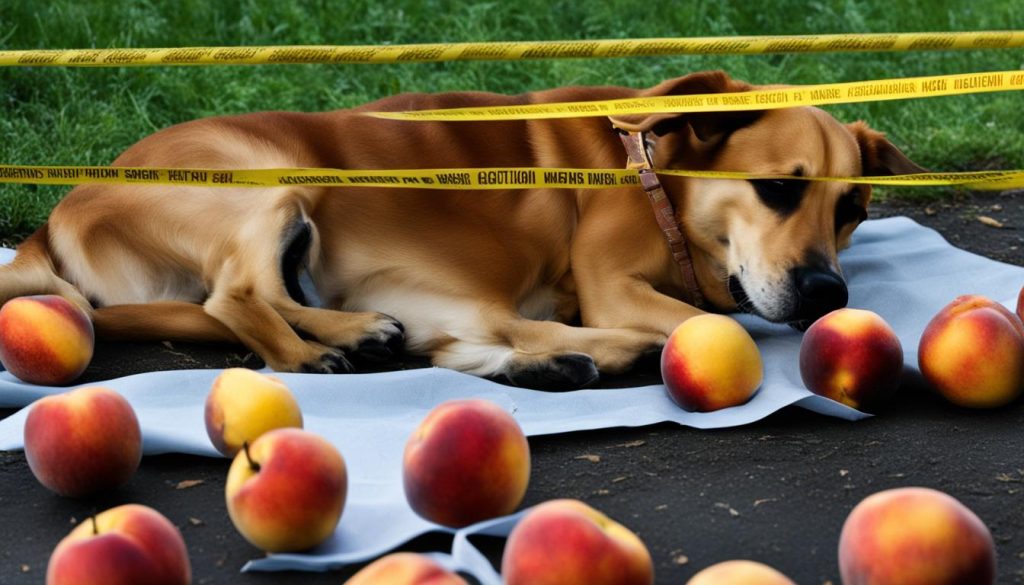Whenever I sit down to savor a ripe, succulent nectarine, those big puppy eyes inevitably follow, tempting me to share. The question invariably strikes me: “Can dogs eat nectarines?” Paramount Pet Health’s Dr. Michelle Burch confirms that, indeed, dogs and nectarines can mix under the right conditions. The fruit offers a bounty of fiber, vitamins, and antioxidants beneficial to our faithful companions. Yet, caution must be exercised; the seeds are a choking hazard and could cause intestinal obstruction, and spoiled nectarines may lead to toxic mycotoxin poisoning, manifesting in symptoms such as vomiting and an elevated heart rate. The key to sharing nectarines with our four-legged friends lies in moderation and mindfulness—ensuring they’re ripe, pit-free, and enjoyed in small amounts for the welfare of our beloved canines.
Can Dogs Eat Nectarines? In small amounts, yes they can.
- Nectarines can be a beneficial treat for dogs, offering fiber, vitamins, and antioxidants.
- Always remove pits from nectarines to prevent choking and avoid the risk of cyanide poisoning.
- Limit nectarine treats to avoid potential gastrointestinal issues and monitor for any reactions.
- Ensure that nectarines are fresh, and watch out for signs of mycotoxin poisoning in dogs.
- Consult with your vet before introducing nectarines into your dog’s diet, especially if they have health conditions.
Can Dogs Eat Nectarines: Uncovering the Nutritional Facts
As I slice into a ripe nectarine and savor the sweet aroma, I can’t help but ponder on the nutritional implications for my dog. With each juicy bite, I’m aware that sharing this treat means more than just indulging in its deliciousness; it’s about introducing a source of vital nutrients into my dog’s diet. So, when the topic of feeding nectarines to dogs comes up, I’m eager to share the nutritional facts and how they can benefit our loyal companions.
Nutritional Benefits of Nectarines for Canines
Luscious and nutritious, nectarines offer my furry friend a spectrum of health perks. Understanding the benefits of nectarines for dogs starts with acknowledging their fiber content, which aids in my dog’s digestive health. But the advantages don’t stop there; the vitamin A present in this fruit can do wonders for his vision, not to mention his skin and coat, ensuring he stays as vibrant on the outside as he feels on the inside.
Vital Vitamins and Minerals in Nectarines
It’s not just about the sweet flavor; it’s also about the inner workings of my dog’s body. The potassium and magnesium in nectarines are key players in muscle and nerve function as well as bone health. Each segment of nectarine I consider for my dog’s bowl is a step towards promoting his overall physical well-being.
The Role of Antioxidants and Phytonutrients
Beyond the basic vitamins and minerals, nectarines are bustling with antioxidants and phytonutrients, putting up a tough defense against diseases and boosting the immune system. By integrating nectarines in my dog’s diet cautiously, I’m offering him not just a treat, but a shield against potential health concerns – a decision any loving pet parent will cherish.
When dishing out slices of this sun-kissed fruit, I’m always mindful of limiting the portions. Nectarines hold natural sugar, which, while harmless in small doses, necessitates moderation to maintain the balance in my dog’s diet. After all, a happy dog is a healthy dog, and that makes for a happy pet parent.
Understanding the Risks: When Nectarines Can Harm Dogs
As I slice into the succulent flesh of a nectarine, sharing a piece with my furry friend might seem like a treat, but it’s essential to consider whether nectarines harm dogs. The truth is, nectarines can bring joy and nutrition, yet they may also introduce risks. The most immediate danger comes from the pit. It’s not just about the choking hazard; these pits harbor traces of cyanide, a toxin that could be released if the pit is damaged or ingested by an adventurous pooch.

There’s also the issue of fiber. While fiber is crucial for a dog’s digestion, an excess can lead to some unpleasant after-effects, namely diarrhea and vomiting. And let’s not forget about nectarines and dog allergies. It’s less common, but some dogs might react adversely to nectarines or any new food introduced to their diet. Then there’s the sugar content—nectarines pack a sweet punch, which can be problematic for dogs with diabetes or those on the verge of obesity.
Given these concerns, precautions for dogs eating nectarines should be at the forefront of any pet owner’s mind. Monitor them carefully after they’ve had a taste of this stone fruit, and always consult with a veterinarian to discuss how nectarines fit into their diet, especially if they have existing health conditions. The key lies in moderation and vigilant observation, ensuring that you can enjoy nectarines together safely.
Feeding Nectarines to Dogs: How to Do It Safely
As someone constantly looking for ways to enrich my dog’s diet while ensuring their safety, I’ve done considerable research on how can dogs eat nectarines safely. Nectarines can be a healthy snack for dogs if given in moderation and prepared correctly. It’s a bit like treating myself to a sweet dessert – enjoying it occasionally and in small amounts is key.

Serving Size and Frequency Recommendations
Based on Dr. Burch’s advice, feeding my pooch one slice of nectarine per day suffices. This quantity ensures that my furry friend gets to savor the taste and nutritional benefits without risking an upset stomach. It’s important to adjust the portion size according to the size of your dog – less for small breeds and a tad more for larger ones.
Preparation Tips for Nectarine as a Dog Treat
Before my dog digs into their fruity treat, I always take the time to wash the nectarine thoroughly to eliminate pesticides. Removing the pit is crucial because it prevents choking and exposure to harmful substances. I slice the nectarine into chewable pieces, making sure they’re the perfect bite-size for my dog. By opting for fresh, preferably organic nectarines and removing all pits, feeding nectarines to dogs can indeed become a safe and enjoyable practice. After introducing nectarines to their diet, I watch for any signs of discomfort or allergic reaction to ensure their continued well-being. Moderate, careful feeding is the mantra I follow for a happy, healthy pooch.
Dogs and Nectarines: Identifying Potential Allergies and Reactions
As a pet owner, I’m always cautious about the new foods I introduce to my dog’s diet. Nectarines can be a great source of vitamins and antioxidants for humans, but when it comes to our canine companions, they may present a risk of allergies or adverse reactions. It’s crucial to be vigilant when you first offer your dog nectarines. Watch for signs of gastrointestinal distress which could manifest as upset stomach, or for allergic reactions, which might include symptoms like excessive scratching or unusual swelling.
Regarding nectarines and canine health, moderation is key. If you notice any peculiar behavior or if your dog exhibits symptoms such as difficulty breathing, lethargy, or any other dramatic changes in their health after consuming nectarines, seek immediate veterinary care. These could be indicators of more serious conditions such as mycotoxin poisoning, especially if the nectarines were overripe or spoiled. The well-being of our pets is paramount, and recognizing when a certain food doesn’t agree with them is part of responsible pet ownership.
For those wondering, “Can dogs eat nectarines?” the answer isn’t a simple yes or no. While these fruits can be beneficial, it’s essential to introduce them gradually. By feeding nectarines in small amounts, you can closely monitor your dog for any adverse reactions, which is vital for determining if nectarines should be a regular treat in their diet. If you’re concerned about nectarines and dog allergies, start with a tiny piece of the fruit, making sure to avoid the pit and any parts that might cause choking or toxicity, and then observe your dog carefully.
FAQ
Can dogs eat nectarines?
Yes, dogs can eat nectarines in moderation. They are a source of vitamins and fiber, which can benefit a dog’s health, but should be given as an occasional treat.
Are nectarines safe for dogs?
Nectarines are safe for dogs if served properly—without the pit, which can be a choking hazard or poison risk, and in small quantities to avoid stomach upset or complicated issues for diabetic or overweight dogs.
What are the nutritional benefits of nectarines for canines?
Nectarines provide fiber, which aids in digestion, and are high in vitamins like vitamin A for good vision, skin, and coat health. Potassium and magnesium support muscle and bone health, while antioxidants support the immune system.
What vitamins and minerals in nectarines are beneficial for dogs?
The essential vitamins and minerals in nectarines for dogs include vitamin A for vision and immune health, vitamin C for antioxidants, potassium for muscle function, and dietary fiber for digestive health.
How do antioxidants and phytonutrients in nectarines benefit dogs?
Antioxidants and phytonutrients can improve a dog’s immune response, reduce inflammation, and potentially lower the risk of chronic diseases, helping to maintain overall good health.
Can nectarines harm dogs?
Nectarines can harm dogs if they consume the pit, which is a choking hazard and contains traces of cyanide. Overconsumption or eating rotten nectarines can also lead to gastrointestinal upset or mycotoxin poisoning.
What precautions should be taken when feeding nectarines to dogs?
Remove the pit and wash the fruit thoroughly before serving to eliminate the risk of choking and pesticide residues. Monitor portions to avoid overconsumption and consult your vet if your dog has any health conditions.
How can dogs eat nectarines safely?
To safely feed dogs nectarines, offer them in moderate amounts, ensure the fruit is free from pits, and slice it into appropriate sizes for your dog to easily consume. Always supervise the first introduction of nectarines to your dog’s diet.
What serving size and frequency is recommended when feeding dogs nectarines?
It’s recommended that dogs are given no more than one slice of nectarine per day. This quantity is suggested for an average-sized dog to minimize the risk of stomach upset or other potential health issues.
What are some preparation tips for nectarines as a dog treat?
Before giving nectarine as a treat, make sure it’s fresh, organic if possible, thoroughly washed, and properly pitted. Cut the fruit into small slices or chunks that are easy for your dog to chew.
How can I identify potential allergies or reactions in dogs to nectarines?
Observe your dog for gastrointestinal discomfort, allergic reactions like itching or swelling, or any unusual behaviors after eating nectarines. If any adverse reaction occurs, seek veterinary care promptly.






